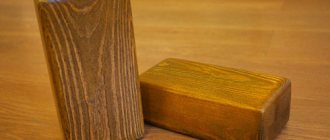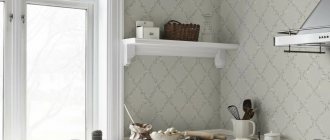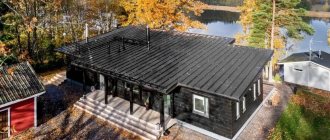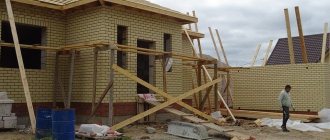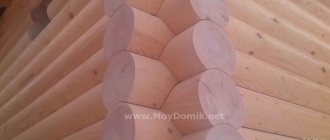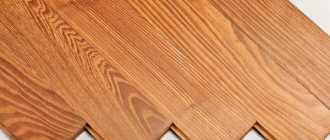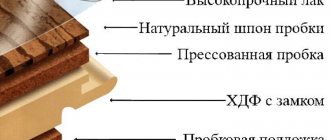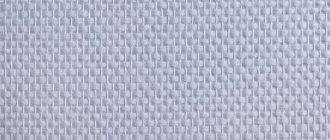The pros and cons of wooden houses influence the choice of material for building a house. All building materials have their own characteristics, advantages and disadvantages. When choosing material for the walls of your home, these questions are of particular concern. Let's look at the pros and cons of wooden houses.
Even a person who has never encountered construction production knows that wood is one of the most ancient and traditional building materials. Wood is also an environmentally friendly material given by nature. The structure of wood gives the house the ability to “breathe”, and coniferous wood, in addition, improves the atmosphere in the house.
A modern wooden house can be built from different types of high-tech building materials. These include profiled timber, laminated veneer lumber, and rounded logs. Each of these materials has technological features.
The main advantages of wooden houses
First, let's look at the advantages of a wooden house
1. Ecological cleanliness
When it comes to the benefits of wooden buildings, the first thing that comes to mind is the environmental friendliness of the material used. Indeed, in terms of this indicator, the tree simply has no competitors. Judge for yourself: deforestation practically does not harm the environment, the material does not emit harmful emissions, and besides, it is waste-free, because both shavings and sawdust are used to make building materials. It is not surprising that people who think about their health and the health of their children give preference to wood when building a house.
2. Wellness
Wood is not only an environmentally safe material, but also extremely beneficial for health. Wood allows air to penetrate into the room, thereby maintaining a healthy microclimate. A person who has lived in a wooden house for several days will undoubtedly feel that it is much easier to breathe in it. In a brick or gas silicate house, this will require installing a ventilation system and installing an air conditioner.
There is scientific evidence that certain types of wood, in particular pine and cedar, can neutralize harmful substances present in the air. The ethers that such a tree produces kill harmful microbes flying in the air. This means the air in a wooden house is much cleaner, which is another advantage of this building material. People suffering from allergies will especially appreciate such houses. Wood does not attract dust, making a wooden frame a real salvation for allergy sufferers.
3. Low time costs
In terms of time, a wooden house made of timber is erected much faster than a brick or concrete structure of the same size. In addition, it is lighter, and therefore such a structure does not require too large a foundation, which also reduces construction time. Therefore, if you want to quickly build a house and at the same time save significantly on building a foundation and hiring a team of builders, choose the most budget option, namely a wooden house.
4. Structural strength
Wooden construction is extremely stable, especially when it comes to the shrinkage of the structure. Where a building made of concrete or brick cannot withstand and cracks, a house made of timber, thanks to the elasticity of the material and the unique connection, remains intact and unharmed. Moreover, wooden structures withstand ground vibrations well, which is another important advantage compared to rigid concrete or brick structures.
5. Great appearance
No other house can compare in beauty to a wooden house. A brick or cinder block dwelling will require exterior finishing to give the building a presentable appearance. And these are serious time and financial costs. With a wooden house everything is much simpler! Rounded logs or laminated veneer lumber initially attract the attention of others. It is only important to treat the wood with special impregnations and cover it with several layers of varnish to preserve this beauty in its original form.
6. Excellent thermal insulation
Wood retains heat indoors several times better, making it much warmer in winter in such a house than in a brick or concrete one. Moreover, the insulation of such a home requires much less materials, which indicates economic benefits. And if it gets cold over time, you can insulate it.
7. Psychological comfort and coziness
Most people cannot imagine a country house made of any other materials other than wood. It’s just that on a subconscious level, a wooden house is identified with nature and relaxation, which is what people strive for when leaving the stuffy city. Such a house exudes warmth and comfort, it is pleasant to touch, and even looking at the varnished surface of the wood, a person receives indescribable aesthetic pleasure. Not to mention the wood smells nice. Concrete or brick will never create such a feeling of comfort.
8. Versatility
Let's also talk about such an extraordinary feature as the ability to dismantle a wooden house in one place and move it to another. Of course, this will require outside help, or better yet, a team of professionals who will dismantle the house log by log and be able to reassemble it in its original form. Of course, such manipulations will not be cheap, but buildings made of any other materials do not have this opportunity, and therefore versatility can be called another advantage of wooden buildings.
Disadvantages of wooden houses
Like any other material, wood is not without its drawbacks. It is also worth knowing about them when choosing what to build your own home from.
1. Short life
The “life” of a wooden house is on average limited to 40-50 years, after which the base and lower crowns of the building become unusable, and the house becomes unsafe. In fact, half a century is a considerable period of time, but it is incomparably shorter than for houses made of brick or natural stone.
There is one feature that prevents wood from being called the best finishing material in the world. Wood cannot withstand moisture, and therefore, over time, rotting processes begin in it and termites settle in. Naturally, under the influence of these unfavorable factors, the tree gradually turns into dust.
In order to protect your home from moisture and insects for a long time, the wood should be treated with special impregnations and also varnished in several layers. A budget option would be to paint the outer surface, but in this case you will lose the natural texture of the wood for which this material is so valued.
2. Fire hazard
Wood is flammable and burns well, which means that a fire can easily occur in such a home. Moreover, ill-wishers can simply set fire to a wooden house. This simply will not work with a concrete or brick structure, because the listed materials do not burn.
It is impossible to completely protect such a house from fire. The likelihood of fire can be reduced by using special fire-fighting impregnations. In addition, you must install fire detectors in the room and keep a couple of fire extinguishers within walking distance.
Important! According to statistics, in 80% of fires in wooden houses occur due to malfunctioning electricity (including power surges, short circuits or damage to electrical wiring by rodents). Therefore, if you decide to conduct wiring in a wooden house, entrust this process to professionals.
Alternatively, use metal pipes to insulate the wires. It is only important that the holes through which metal pipes with wiring pass are drilled at an angle. This is necessary so that condensation does not accumulate on the metal surface and it does not rust.
3. Shrinkage
We have already mentioned that a wooden house is more flexible and elastic compared to brick or concrete buildings. However, a wooden house also shrinks. And this process lasts approximately one year. Obviously, at this time it is difficult, and sometimes almost impossible, to carry out interior finishing work. If you decide to take this step, be prepared for the fact that your work may go down the drain.
A way out could be to use laminated veneer lumber as a material. It must be high-quality, well-dried material that will not dry out or deform.
4. High cost
If we talk about the cost of materials for the construction of a residential building, then good wood is really expensive, an order of magnitude more expensive than brick or reinforced concrete. However, if you decide to buy a wooden house, you shouldn’t skimp on the material. Soft and low-quality wood will rapidly deteriorate; even high-quality treatment with impregnations and varnish will not save it from rotting! Having saved on wood, be prepared to replace individual parts of the structure in 10-15 years.
Today, the optimal solution when building a wooden house is the use of laminated veneer lumber. It is noticeably cheaper than solid logs, but even it cannot be classified as a budget option.
Which material is better for construction?
Builders pay attention to the tree species that grow in Russia. Among the most popular are larch and oak. Larch is a more affordable option than oak. Its main advantages:
- resin that repels pests;
- the same resin creates a pleasant aroma on a permanent basis;
- the material is not picky;
- treatment once every few years.
Oak is not inferior in the number of advantages; it has:
- strength;
- long service life;
- small amount of moisture content;
- high hardness.
When choosing, be sure to pay attention to the company that provides the material. It must be on the market for at least 8 years, have many positive reviews and a large network throughout the Russian Federation. Be sure to look at the information about the material; it must have a high degree of drying, otherwise over time the structure will dry out and become deformed.
This nuance also applies to wooden floors in the house , which should be as dry as possible. The optimal drying period is at least 2 weeks in production, naturally – 3 years.
Brick buildings do not require drying, and the choice of material is more varied. Currently, there are more than 10 types of bricks, which differ from each other in purpose of use, manufacturing method, nature of filling, etc.
Pros and cons of wooden houses depending on the material
In addition to the general pros and cons of wooden houses, this issue must also be considered based on the specific material. Not only the cost of the future home, but also its aesthetic appearance, durability, ability to retain heat and many other important factors depend on the type of wood and the shape of the material.
- Pine
The most popular option among the population is pine. This is the most budget option, which, moreover, is easy to process;
- Spruce
Excellent rounded logs are obtained from spruce, which itself is very smooth. However, spruce has too many knots, and besides, the wood is fragile and difficult to process;
- Larch
The house made of larch looks rich. But it is one of the most expensive wood options. The bottom line is that larch for building houses is brought from the Altai Mountains, which affects the final cost;
- Cedar
The most sophisticated option for building a house is cedar. This is the most expensive option, and not only because of the need to transport logs from Siberia. Cedar is the highest quality material, resistant to decay and with excellent aesthetic characteristics;
- Linden and aspen
Linden and aspen can be found almost everywhere. The cost of such wood is not too high, but it is used mainly in the construction of bathhouses, and all because this material tolerates temperature changes well and is resistant to high humidity.
Chopped log
This is a classic log that has been used to build residential buildings for many centuries. Today, such a log has not lost its relevance, and all because a house made from such a log turns out to be original, which is very much appreciated by buyers. In this case, the production of the material is not particularly difficult. All you need to do is clear the trunk of bark and cut off the protruding branches. Along the edges of such logs, special niches and projections are formed, thanks to which neighboring logs are assembled into a castle.
Important! In the old days, craftsmen built wooden log houses without a single nail!
The huge advantage of this material is that you can actually make it yourself, without the help of professionals. This is an excellent solution, considering that hand-made hewn logs by professionals are not cheap. In addition, a house made of such logs retains heat well, and the structure is considered one of the most reliable.
If we talk about the disadvantages of such material, then it is important to understand that chopped logs are not produced industrially. It is made by hand, and therefore each log has to be adjusted to fit the existing structure. That is why such material is made individually, i.e. they build a log house, adjusting each subsequent element to the previous one.
Important! If desired, one or even two sides of a chopped log can be trimmed down until a plane is formed. Among carpenters, such logs are called “carriage” or “half-carriage”. This approach improves the appearance of the log house and increases the usable space inside the house. However, the cost of such logs increases by at least 30%.
Rounded log
Incredibly stylish and visually attractive is a house built from cylindered logs. Each such log is passed through a special machine, which gives it an ideal cylindrical shape. Thanks to this, a house made of rounded logs does not require additional finishing.
Important! True connoisseurs note that a rounded log no longer looks as authentic as a hewn one, and this inevitably affects the cost.
Indeed, with such a unique appearance, a rounded log is cheaper than a chopped one, and all because manual labor is minimized in the process of its production. But there is also an undeniable advantage. Assembling a house from such material will not be difficult, because all the parts are calibrated in production and fit together perfectly.
It is only important to understand that you can purchase and build a house from such material only if the log is well dried. Otherwise, the wood may crack, and the finished house will shrink within a year. But if you use high-quality dry logs for construction, the finishing of the room can be done immediately after the construction of the house.
Rectangular beam
Quite new, and therefore original, is the decision to use a rectangular beam to build your home. Such a house looks attractive, and besides, it has noticeably more usable space inside.
But the issue of using high-quality material in this case is even more acute than when choosing rounded timber. The bottom line is that it is quite difficult to dry such material and at the same time maintain its straightness. It is for this reason that manufacturers produce timber with a cross-section of 150x150mm, since products with a larger cross-section can be deformed during the drying process. All this affects the price of rectangular timber, which not everyone can afford.
We will only add that in winter it can be cool in such a house, and therefore people who intend to live in it all year round will have to think about additional insulation.
Glued laminated timber
In recent years, one can increasingly see houses built from so-called laminated veneer lumber. From the name you can understand that such material is prepared by gluing several boards into a single log. What does this give? First of all, such timber is incredibly durable thanks to the plate assembly. The solid adhesive composition also provides additional strength to the structure.
Unlike the options described above, laminated veneer lumber is practically not deformed, which means that a house assembled from such material does not shrink. Work on its finishing can begin immediately after the construction of the building.
Problems can only arise if you purchased low-quality material. If the manufacturer skimps on the adhesive composition, the boards may come apart during use. And fixing the situation will not be easy at all.
Frame houses
As a bonus, we will also tell you about such a popular option for a private wooden building today as a frame house. It is erected from ready-made SIP panels, wooden analogues of sandwich panels. In this regard, building a house is more reminiscent not of the classic laying of logs on logs, but of assembling a puzzle.
The main advantage of a frame house is that it can be erected in literally 1-2 days. In addition, assembling such a house is not difficult, and the panels do not require adjustment. All this saves the customer time and money. Finishing can be done immediately after assembly, which is also an advantage.
Speaking about the disadvantages of such a structure, it must be said that a frame house does not retain heat well, and therefore requires thorough insulation. But even in this case, in the northern regions of our country, such houses have not become widespread.
Production technology
The manufacturing technology of profiled laminated veneer lumber consists of gluing together thin layers of dried and treated wood with a special glue, and adjacent layers have different fiber directions, which makes the timber resistant to heavy loads and temporary deformation. The glue is absolutely harmless and gives additional rigidity to the entire beam. Profiled timber, made using a unique technology, is not susceptible to internal stress, does not crack, and does not deform. After gluing and drying, the timber is profiled on special four-sided machines, where the tongue-and-groove joint is made. This is one of the most important operations; the quality of the entire building will depend on its quality. After this, the beam is trimmed, cut into parts of the required size, crown cups and holes for dowels are made - metal pins for transverse fastening of the beam.
